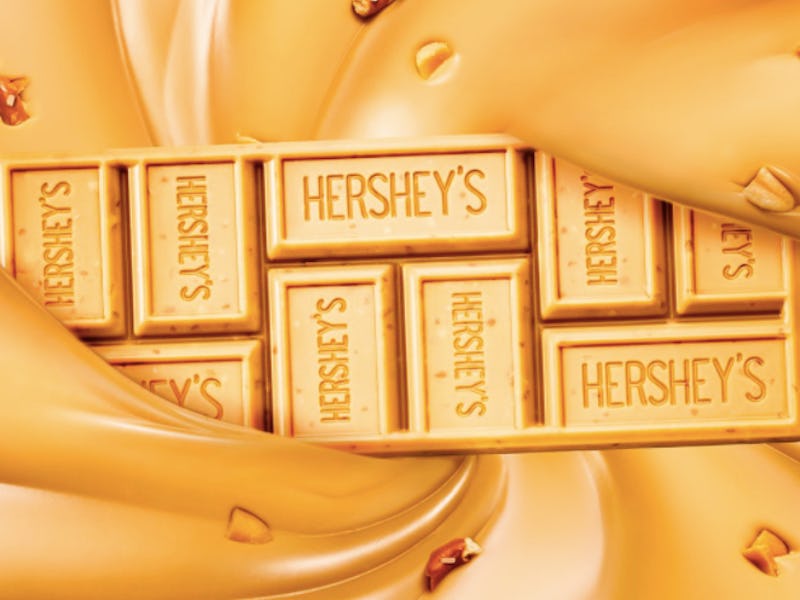Hershey's New 'Gold' Chocolate Bar Will Use Science to Game Your Mouth
A basic chemistry hack guarantees it'll be delicious.

Since its inception in 1894, the Hershey Company has developed exactly three signature chocolate bars: Original, Special Dark, and Cookies ‘n Creme. If you had to sum up the company’s gastronomical ethos in one word, you could simply call it ‘basic’. But now, the company appears to be attempting a rebrand by announcing the release of Hershey’s Gold, a bar that defies the conservative flavor profiles of its uniformly sweet predecessors.
Hershey’s Gold, a “caramelized cream bar embedded with salty peanut and pretzel bits,” sounds it will be a mouth-orgy of contrasts, dominated by savory and sweet flavors. And that’s why it’s probably going to make a killing.
Salty-sweet snacks are nothing new, but the popularity of the flavor combination seems to have been driven by millennial tastes, according to some consumer reports. But at least part of the reason that it’s hit the mainstream is because the combination is scientifically proven to titillate your taste buds.
Hershey's Gold will be studded with salt-covered pretzel bits as well as peanuts.
When Hershey’s Gold hits your tongue, its flavor molecules will melt across its surface, where specialized taste buds will pick up on five flavors: sweet, salty, sour, bitter, and umami. Obviously, bitterness is a flavor that should probably take a backseat to sweetness in a chocolate bar, but canceling it out isn’t always easy to do chemically.
But in 2001, scientists publishing in the International Journal for Chemistry showed that the presence of sodium salt (like sodium chloride, which is regular table salt) suppresses the bitter taste receptors, allowing ‘favorable’ flavors to shine. It’s an especially useful chemical trick in the case of Hershey’s Gold because pretzels are normally slightly bitter because of the baking soda or lye solution they’re soaked in — that’s why they’re always studded with salt.
Salt: masks bitterness and keeps your blood pressure up!
Furthermore, other research, published in the Proceedings of the National Academy of Sciences by scientists from the Monell Chemical Senses Center in 2011, has shown that certain sweet receptors on the tongue only work if salt is present. Without salt, these receptors won’t register sweet flavors, even if they’re all over the tongue.
Some scientists suggest that there’s an evolutionary reason we crave the salty-sweet combination in food. Our ancestors were always seeking out high-calorie food to fuel their bodies, and sugary foods, as we all know, tend to be especially fattening. But all that sugar wasn’t useful if the body didn’t get the salts it needed in order to function — salt deficiency makes it impossible for cells to signal and causes dangerous drops in blood pressure — which is why humans crave salt, too. The idea is that early humans realized they hit nutritional pay dirt when they came across food that was both sweet and salty, and so we learned to prefer these foods.
Some would argue that the existence of Hawaiian pizza is consistent with human evolution.
Of course, most humans are neither salt nor sugar deficient these days, so the appeal of Hershey’s Gold is mostly a vestige of our once-deprived ancestors’ appetites. Luckily for The Hershey Company, those cravings appear to be as strong as our hunger for novelty.
If you liked this article, check out this video on how chocolate will have 40 percent less sugar without affecting the taste. That’s twice as much chocolate you can eat!